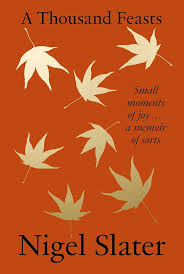Inspiring Older Readers
 posted on 23 Jan 2025
posted on 23 Jan 2025
A Thousand Feasts by Nigel Slater
Middle-class celebrity cooks in grandly appointed kitchens. The world seems full of them. They co-exist with a global food crisis in which many people don’t know how to cook, many cannot afford to cook, many more are starving, and the rich countries stuff themselves with cheap ultra-processed food that does nothing but hasten ill-health. At the risk of sounding sanctimonious, these contradictions are impossible not to see and as a matter of principle I generally avoid every aspect of the celebrity chef racket.
But for writer, cook, broadcaster, journalist and editor Nigel Slater I make an exception. In my own mind I even grant him exclusion from the ‘celebrity cook’ category. Like many I feel I have grown up with him. I remember reading his Observer columns and articles when they seemed something of a secret pleasure, frequently accompanied by Jonathan Lovekin’s beautiful, softly lit, deeply saturated photographs. But over the decades, sheer Stakhanovite industry has enabled Slater to achieve the impossible: he has built an empire of food writing, publishing, cooking, broadcasting and journalism while remaining one of the good guys. And he has done this while also writing like an angel.
And this is especially evident in his latest book, A Thousand Feasts. Now, I could no more read a book of recipes than I could write one, but there is something that I have always regarded as a special treat in Slater’s food writing: you get the recipe but you also get some exquisite incidental writing – its beauty resting on its acute observation and apparent effortlessness. I don’t think anyone else in food writing, certainly not producing the sheer volume that Slater does, even begins to approach this level of craftsmanship.
And in a sense, that’s what this latest book is – a collection of the best bits of incidental writing, fragments, observations, exquisite descriptions, what Virginia Woolf would have called ‘moments of being’ but which Slater has the modesty to call ‘moments of joy’.
Amongst his voluminous output are two books that stand furthest away from the routine of the working cook and food writer and these are his childhood memoir, Toast: The Story of a Boy’s Hunger (Letterpress review here) and my personal favourite, The Christmas Chronicles (Letterpress review here) and it is alongside these two books that A Thousand Feasts needs to be considered, I think. It is a book to whet the appetite rather than a book to cook from.
In his introduction Slater seems to suggest that he conceived it as a book for dipping into, but this isn’t how I’ve been reading it. I have been relishing its short, beautifully written and impeccably observed pieces simply for their wonderful prose. One really does feel that every word has been weighed and judged for its usefulness, sense and elegance, and after a long, rich, exhausting period over Christmas spent reading Dickens’s Great Expectations for the first time Slater’s prose comes with the bright, palate-cleansing tartness and lightness of some of the foods he most seems to crave – as vivid as the ‘tangle of wild mountain greens in tempura batter, presented on a disc of white paper, like a flower preserved in ice,’ that he eats in Hokkaido.
Most of the short pieces are food memories linked to particular places. Japan features heavily, as do Norway, Finland, Iceland, Greece, the Middle East. Later pieces reflect on the usefulness and beauty of cherished old kitchen implements, his London garden, making a home, and the physicality and pleasures of preparing food. But it isn’t all food. These are also feasts of the senses – sights, sounds, smells, intensely recalled. Many of the pieces also share an additional underlying theme – that of staying fresh and rested and sane despite an almost impossibly busy work schedule, seeking out the moments that prove to us (but most of all, I suspect, to Slater himself) that this show can be kept on the road – and still enjoyed.
Many of the pieces are in two parts: the first, a couple of hundred words or so on the main topic; the second, a sort of follow-on reflection, typically only a sentence or two, but quite haiku-like. Here’s an example: ‘Kitchen table, spring afternoon. Sorting seeds for the vegetable patch. A glass of fino sherry the colour of straw.’ It is to Slater’s credit that he pulls this off repeatedly without appearing mannered or laborious.
I love Slater’s prose and I admire his sensibility and if I’m perfectly honest I suppose I rather envy his lifestyle, and so I find this book deeply pleasurable. I would well understand if others find it all a bit precious and overwhelmingly middle-class, but I don’t. It is a miracle that I don’t, but there we are – it is all about the quality of the prose: when you can write as well as Slater, you can write about pretty well any subject you want.
It is also a beautifully produced book. I think Slater plays a big part in the design of what he publishes and I’m fairly certain one can see his hand in this – the matching autumnal shade of the boards, endpapers and lightly textured jacket, the falling leaves on the cover picked out in gold foil and repeated throughout as simple page ornaments, the quality paper and decent printing. A delight.
Alun Severn
January 2025